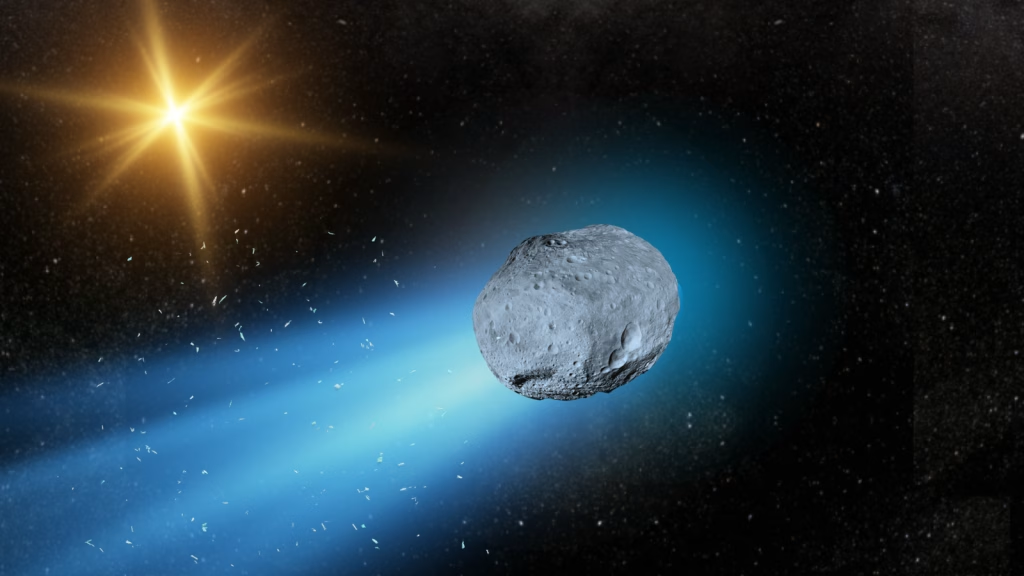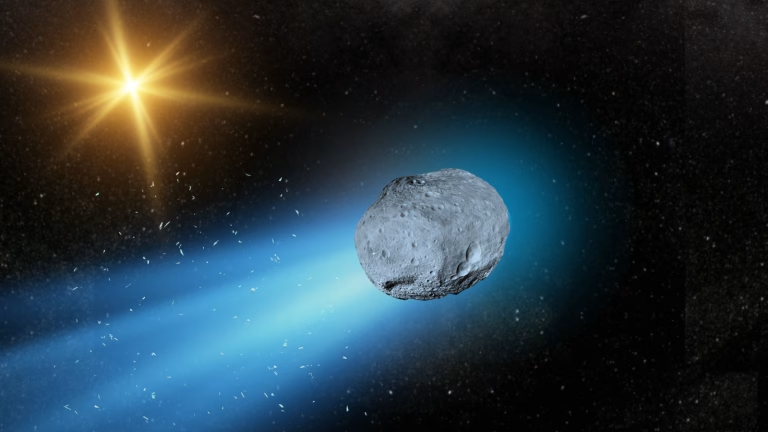What Is 3I/ATLAS?
3I/ATLAS, also known as C/2025 N1 (ATLAS), is a comet — a ball of rock, dust, and frozen gases that travels through space. But this one is very special.

Most comets come from the outer parts of our own Solar System, but 3I/ATLAS came from another star system — far beyond the reach of our Sun. That’s why scientists call it interstellar, meaning it comes from between the stars.
Think of it as a visitor from another neighborhood in the galaxy. It entered our Solar System by chance and is now passing through before heading back into deep space.
It was discovered on July 1, 2025, by the ATLAS telescope system in Hawaii — the same system that watches the sky for asteroids that could come close to Earth.
What Happens on October 29, 2025
On this date, 3I/ATLAS will pass closest to the Sun — a moment called perihelion.
- Distance from the Sun: About 203 million kilometers — much farther than Earth’s orbit.
- Speed: Around 65 to 70 kilometers per second, or over 250,000 km per hour — faster than any spacecraft ever built.
Even at that speed, it stays far away from Earth, so there’s no danger of impact.
Will It Come Close to Earth?
No, not at all.
At its closest point, 3I/ATLAS will still be about 270 million kilometers from Earth — nearly twice the distance between the Earth and the Sun.
That’s extremely far away. It poses no risk, and astronomers have confirmed its safe path. It’s just passing through quietly.
Why Scientists Are Excited
Even though it’s harmless, 3I/ATLAS is exciting because it’s made of material from another solar system. Studying it can teach us what planets and stars are made of elsewhere in the galaxy.

Telescopes have already spotted some strange things:
- It has a lot more carbon dioxide than normal comets.
- It shines with a greenish glow, showing unusual gases.
- It may even have tiny bits of iron and nickel, rare for comets.
To scientists, it’s like finding a message in a bottle that drifted all the way from another ocean.
Can You See It from Kenya?
From Kenya and East Africa, you might be able to spot it using a telescope or strong binoculars under dark skies. It’s too faint to see with the naked eye.
If you want to try:
- Go somewhere far from city lights.
- Check TheSkyLive.com for viewing times.
- Look west after sunset in late October.
Even if you can’t see it, just knowing a comet from another star is passing by is amazing enough.
What Happens After
After October 29, 2025, 3I/ATLAS will fly out of the Solar System forever. It won’t come back.
Astronomers will continue watching it with the James Webb and Hubble telescopes, studying what it’s made of and where it might have come from.
The Bottom Line
3I/ATLAS is completely safe — it will not come anywhere near Earth.
It’s simply a cosmic visitor, traveling faster than any rocket, giving us a glimpse of what lies beyond our own Solar System.
On October 29, 2025, you can look up and remember: somewhere out there, a piece of another world is passing by — a quiet reminder of how big and beautiful our galaxy really is. Read more about it https://m.economictimes.com/news/international/us/where-will-3i/atlas-be-on-october-29-interstellar-comets-closest-point-to-the-sun-is-all-details-here-astronomers-mars-telescopes-discovery-origin-atlas-telescope-esa-nasa-unique-characteristics/articleshow/124773865.cms
More stories https://www.whispers.co.ke/

